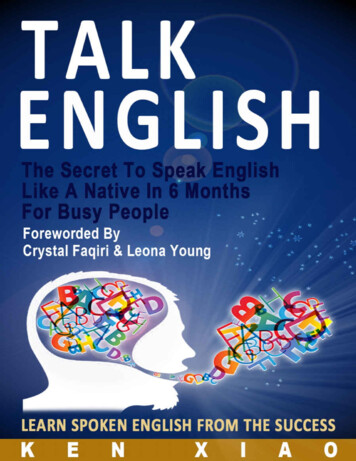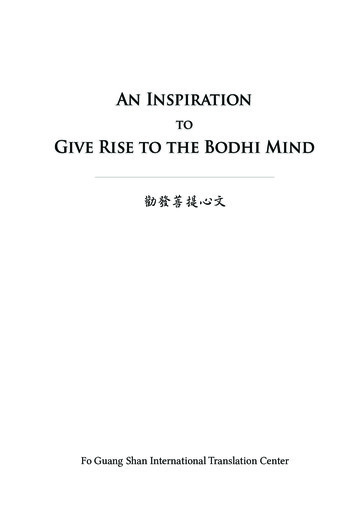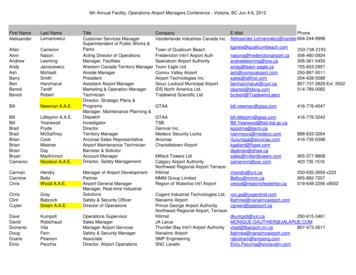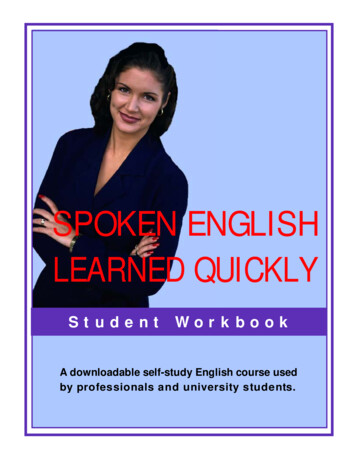
Transcription
Talk English – Ken XiaoTalk EnglishThe Secret To Speak English Like A Native In 6 Months For Busy People,Learn Spoken English From The SuccessKen Xiao
THIS is the book every English learner NEEDS to read.Crystal F. , CanadaAfter 2 weeks, the change is significant. Most importantly I think like a native speaker starting buildinga little bit in my subconsciousness.Dexuan L., ChinaHow I can speak English so fast without accent? With your tips I can do it. I will recommend to myfriends with broken English because I think your book is very helpful for me and other people like meto learn speak fluent English. Thank you so much!Farah A., IranThe book provides the readers a workable way on how to get to speak fluent English. It's simple,straightforward, and most important of all, its focused and not too way long to cost the readers toomuch time.Joanne L., Hong KongI like your book especially all of your suggestions how to improve the English and soften the accent.Thanks!Kasia L., PolandThere are so many books , specifically “help” books, out on the market that one can get sooverwhelmed with the selection. This book, catering to the English language fluency, is such a greatbook that there is no need to even scratch your head over the others.Leona Y., Czech Republic
Editor's WordBefore having read the book, my expectations of its effectiveness wereneutral-- I wasn't sure if the 6-month plan that would be set forth by theauthor would be a realistic timeline for an individual's learning needs.Regardless, I dove in with a completely open mind and almost immediatelycame to realize that my doubts were unfounded.The book's main promise was that it would provide its readers with a planthat would transform their broken English into fluent English. After havingread this piece, I can say without a doubt that the book went above andbeyond its initial promise to deliver SO much more. Ken outlined ameticulously detailed regimen that not only explained everything one wouldhave to do in order to improve his or her English (including numerousoriginal strategies and helpful tips) but he also took on the role of anencourager, cheering his reader on throughout the whole read. Certainly, thisbook went above and beyond to deliver much more than its original promise—it delivered a lifestyle change.The strategies that the author has outlined can be applied universally to anylanguage and I would recommend this book to anyone who would like toimprove his or her fluency in a foreign language (most specifically English asthis is what the author focuses on). THIS is the book every English learnerNEEDS to read. What sets this book apart from the myriad of others is theway in which the author connects with his reader; from his words, you can
absolutely feel the suffering he experienced as result of his broken Englishand the triumph that overwhelmed him when he finally succeeded atcommunicating fluently. This book is thoughtful and inspiring and itsgenuine tone will deeply touch its readers.Crystal Faqiri
CopyrightNo part of this publication may be reproduced, transmitted, sold, or utilizedin any form or by any means, electronic or mechanical, includingphotocopying, recording, or by any information storage and retrieval system,without written consent of Ken Xiao.
ForewordThere are so many books , specifically “help” books, out on the market thatone can get so overwhelmed with the selection. This book, catering to theEnglish language fluency, is such a great book that there is no need to evenscratch your head over the others. Ken does an incredible job at making iteasy to read and understand, precise and specific in teaching you what to doto better your English, and most important, he makes it personal. With thepersonal touch, you can really fall deep into the emotions, the battles and thetriumphs of Kens journey. He takes you into a place where you can reallyrelate to him and that makes learning so much easier and more fun!I, myself, am not an American Native. I was born in the Czech Republic andcame to the USA at the age of 4 with my parents. Now as a young child, Ipicked up the English language quite fast, however my parents did not. Asadults, of course, it’s much more difficult to learn a second language, letalone English, which is not that easy! They took English as a secondlanguage courses at a local community college and watched “easy tounderstand” TV shows, which was all fine and helped them learn thelanguage, but if they had Ken’s book at that time, back in the 1980’s, theyreally would have scored!Ken is eager and excited to get this book in your hands. He trusts that his tipsand techniques will help you, just as they did him! I believe that you will findthis book extremely valuable and helpful and hope you enjoy it as much as Idid!
Leona Young
About The AuthorKen XiaoTranslator in the United States Department Of DefenseBachelor of Science in Information TechnologyMaster of Science in Space StudiesCreator of MyFluentEnglish FormulaEnglish teacherPrincipal of Shao Wen School Of EducationBusiness ownerNewspaper editor
Table of ContentsEditor's WordForewordAbout The AuthorIntroduction1 — A Middle School Dropout Can. Can You? (Must read)2 — From Broken English to Fluent English3 — How Fluent? One Word: Native!4 — The Formula To Make You Speak English Like A Native5 — The One Word Secret6 — Get It Right, Baby!7 — This Is Your Right Hand Man8 — The Step-By-Step Instructions – Let's Make You Speak Like A Native!9 — This Is Your Left Hand Man10 — Your Road To Success
You must do the thing you think you cannot do.Eleanor Roosevelt
IntroductionYou have studied English for years, yet you still don't speak English well.You have tried many methods and you still make grammar mistakes, you stillcan't speak English fluently, and you still can't pronounce English wordscorrectly. You can read, but you feel nervous to speak English or too shy tospeak English.The good news is, this is very normal. You have simply used ineffectivemethods to learn to speak English.My name is Ken Xiao. I was in your situation before, but now I can speakEnglish like a native, and I accomplished that in six months without spendinga dime. I'm going to teach you how to completely get rid of your accent anddevelop an American or British accent to speak English just like a nativespeaker, and I'll teach you how to accomplish that in just six months.In this book, you'll learn:* How to speak like a native in six months or less* How to do that effortlessly on a busy schedule* How to speak English without translating it first* How to learn grammar without memorizing grammar rules* How to build a vocabulary that lasts* How to make you pronounce English words like native American or nativeBritish* How to speak English fluently, correctly, and naturally just like a native* And more. to make you speak English like a native speaker.You have studied English for years, yet you still can't speak English well.The reason is simply: The methods you used were ineffective. Change your
way of learning now. Learn from the success who was in your situationbefore and is getting the result you want now. You can succeed by simplydoing what I have done before. Effortlessly follow the step-by-stepinstructions in the book to achieve the highest level of fluency to make youspeak English like a native speaker. Follow the instructions now.
Man is not the creature of circumstances, circumstances arethe creatures of men. We are free agents, and man is morepowerful than matter.Benjamin Disraeli
1 — A Middle School Dropout Can. Can You? (Must read)In a poor farming village in southern China, a child was born. In hischildhood life, he was hungry. SO hungry that even after over 30 years, hestill remembers the hunger he'd been through in vivid details. There was norunning water, so he had to carry water home from a well that was half of akilometer away using two buckets. And he was seven years old. The bucketsof water were SO heavy that he couldn't walk straight. At age 7, he started towork in the fields to plant, cultivate, and harvest crops. At age 7, he started tocollect firewood for cooking. At age 7, he started to cook for the entire familyusing open fire. There was no electric stove, and he was lucky if he gotelectricity for lighting once a week. He started elementary school at age 8 anddropped out of middle school at age 13.He moved to America with his family when he was 17. He spoke no English,went straight to high school, and started to learn English in classes calledEnglish As Second Language (ESL) classes. Since he spoke no English,English certainly wasn't his favorite subject. At age 20, he could speak somebroken English. Then he used a method which I'm about to share with you toimprove his English fluency, and six months later, he turned his brokenEnglish into fluent English. In the following effortless practices, he eventurned his English into an English that people who didn't know him thought itwas his native language.Amazing, isn't it?And here is the best part: This country boy, this middle school dropout,started at 20, for six months, who successfully spoke English like a native,has NO special talent! He's just an average person you and I would see in thecountry sides. He's just an average person you and I would meet on thestreets.This middle school dropout is talking right in front of you. This middleschool dropout is me.And yes, I, Ken Xiao, a country boy, a middle school dropout, an averageman, started at 20, for six months, can speak English like a native!
There is one sole purpose I'm putting my humble background here –inspiration! Because with a background like that and I can still make mespeak English like a native. Can you?What I used to make me speak English like a native was MyfluentenglishFormula. It's a formula I created, improved, and perfected. Using the sameformula, I also made me speak two other languages like a native.If a country boy, a middle school dropout, an average man with no specialtalent, started at age 20, for six months, can make him speak English like anative, my friend, yes, you can. Let's start the six-month journey today to getyour results.To your success,Ken Xiao
My first family picture taken in 1983. I'm the boy standing in the back.
2 — From Broken English to Fluent EnglishWhen I was 20, I could understand some English but not much. Myvocabulary was very limited, my accent was very strong, and I first thoughtin my language, then translated into my own version of English to speak topeople. The problem was, people couldn't understand me.In short, my English was bad.
New York City. I spoke no English when I came to America.
We'll either find a way or make one.Hannibal
The Desire For Change (The ultimate power)What kind of jobs could I get if I could only speak translated, broken Englishwith a strong accent. That inspired me to start looking for opportunities toimprove my English fluency.One day, I watched an advertisement on TV and saw an expert called FluentEnglish Mr. Wang who guaranteed English fluency. He guaranteed that ifyou were just starting to learn English and took lessons from him for a year,your English would be more fluent than others who'd learned English for tenyears. “How amazing is that?” I thought, but there was a problem. FluentEnglish Mr. Wang only offered to teach one-on-one private lessons but Ididn't have the money. By the way, a private lesson at the time was 30 perhour.I wondered what Fluent English Mr. Wang did to get that kind of result, but Ididn't call him because I thought he wouldn't tell me anyways. Then Ithought, “If he can find a way to do it, I can find a way to do it, too!”So I started by reading books from the library on English fluency. All of thebooks I intentionally picked were written by native speakers because Ithought I should learn from the native. There were lots of words I didn't knowbut I looked them up in the dictionary.After I read about 10 books, I summarized all of the strategies into a list of10. The strategies were something like “Listen listen listen,” “Read readread,” “Use what you've learned,” “Build your vocabulary,” and so on.I started applying these strategies, and I could understand a little moreEnglish but the strategies didn't make me speak any better.So I kept reading books, and again, all were written by native speakers. Butthey all said pretty much the same things. I kept reading and reading. As faras I can remember, I read a total of about 60 books, and again all of the booksI intentionally picked were written by native speakers, and all of the bookssaid almost the same things.The strategies were ineffective, so I tried a different approach.
A tape I used to practice English with.Instead of picking books written by native speakers, all the books I pickedthis time were written by successful non-native English speakers who hadmade their English fluent. I picked and read about 10 of them. To mysurprised, all the books said the same things as the 60 books written by nativespeakers EXCEPT for one thing – Repeat what you hear again and again.“Repeat what you hear again and again” wasn't mentioned in any of the 60books written by native speakers at all.Out of the list of 60 books written by native speakers, one was very useful.This book wasn't about how to speak fluent English, instead, it was abouthow to become successful written by Tony Robbins. I came across that bookand wondered for three seconds of whether or not to take it. At the lastmoment, I decided to take it just to take a peek at it in case if there weresomething useful. To my surprise, it turned out to be a great book on how toset goals and how to become successful. I summarized that book and the tenbooks written by the successful non-native English speakers and came upwith one strategy, a strategy I later named Myfluentenglish Formula.The Perfect OpportunityI was 20 at the time, living in the Brooklyn area of New York City. Everyday I took the subway trains to and from Manhattan. The trip took 40 minuteseach way on the train. The walk to the train station from home took 12minutes and the walk from the train station to work took five minutes. Alladded together, a round trip took an hour and 54 minutes each day. Thatcreated a perfect opportunity for me.I brought my Walkman with me while on the way to work and on the wayhome. I normally listened to English lessons and sometimes songs, but after I
read the last 10 books written by non-native speakers and worked out mystrategy, I used the Walkman to try my new strategy – Repeat what you hearagain and again.Taking ActionDuring these round trips, I first tuned in to a news station. It was NPR,National Public Radio, to listen to the news. It worked very well during the12-minute walk to the train station, but once I entered the train station, thesignal was lost. When I got home at night, I recorded the news on a tape forthe next day so that I could listen to it on the train. After that, I recorded freshnews every night.I started by whispering the news, but then I began saying it louder. New Yorksubway trains were as noisy as thunders, and thanks to that! The noisecreated the perfect opportunity for me to work on my strategy – even theperson sitting next to me couldn't hear what I was talking about. So I got topracticed the entire train rides both ways.In the beginning, there were lots of words I didn't understand, but I repeatedthem anyway! In the beginning, the news was too fast for me, but I repeatedwhat I heard even if I couldn't catch up. Often when there was a word or aphrase I couldn't say, I would rewind the tape and listen to it again. This time,I only listened to it. If I still couldn't say it, I would rewind the tape again andlisten again until I could say it. Then I would repeat the word or phrase once,twice, three times until I could correctly say the new word or phrase. Ithelped a lot! The next time I heard that same word or phrase, I couldcorrectly say it.Following ThroughThree months later.I decided to record my own speaking to see how much I had improvedbecause I had heard some people (at least three that I remembered) sayingthat I spoke good English. So I wrote down some daily conversationalphrases and recorded my voice saying them. To my surprise, I DID speakwhat I wrote down pretty fluently! I could still hear my accent but the accent
was much lighter. Compared to other ESL learners, my English was evenbetter!I got excited about the results and decided to slightly adjust my approach.The first thing I changed was recording the news once a week, listening andpracticing the same English from native speakers for a whole week. In thebeginning of the week, there was almost always something I couldn't say. Atthe end of the week, I'd mastered speaking everything on the whole tape. Iwas even almost able to recite everything on the tape including words,sentences, tones, flow.The next week, I recorded a new tape and did the same things for the rest ofthe week. I did it for a month and mastered four tapes of English taught bynative speakers. On week five, I went back to practice the previous fourweeks' English with one tape per day. For the remaining days of the week, Ipracticed the tapes that I had the hardest time with.Within a month, I'd mastered speaking four tapes of English taught all bynative speakers. Each tape was 60 minutes long. Four tapes were 240 minutesof English taught by native speakers.The ResultThree months later.As you may have guessed, I recorded my speaking again and the results weresurprising! My accent was gone, my voice was clear, my pronunciation wascorrect, and my flow was smooth. In other words, my English was fluent!It was a total of six months that I had spent practicing my English, but theresult was overwhelming.After talking to a friend on the phone for a moment, the friend suddenlyasked, “ What did you do?” I said, “Huh? What do you mean?” He said,“Your English! It's GOOD!” I could hear the word “good” was coming fromhis heart. He said the word “good” with a tone that was so sincere that I couldfeel the energy of his voice.
Two of my cousins, both native speakers, asked, “How come YOUR Englishis so good but your brother's and sisters' are not?”The Continuing EffortI didn't just stop there. For the months and years that followed, I continued touse my strategy when I found opportunities even though my situation hadchanged.Years later I developed yet another strategy I called Open Throat, which I'lltalk about in the next chapter. When speaking English with the Open ThroatStrategy, my English sounds absolutely, 100% native.When my son was in first grade, he invited me to read to his class as a guestreader. His teacher was so upset because I looked like I couldn't speakEnglish, which would mean disaster to her class. However, his teacher wasabsolutely stunned when I spoke. I saw her eyes widen for five secondsfollowed by a long smile. She watched quietly as I inspired her students toenjoy the book by talking with 100% enthusiasm and speaking in 100%native English. She then suddenly jumped into action by whipping out hercamera and started taking pictures. She even interrupted me by asking if shecould put a picture in her class newsletter. She later asked if I couldparticipate more to help her in her class activities.
3 — How Fluent? One Word: Native!This is a strategy which I had later developed that brought my fluency to thenext level – native. I called it Open Throat.When practicing, open your throat, talk with your diaphragm, and bring theenergy from your stomach.The energy flow and the way of speaking make a huge difference. To do this,you must open your throat, let the air flow through, and talk with energy fromyour stomach. You should feel your stomach tighten when you talk.So bring your energy up all the way from your stomach, let the air flow fromyour lungs through your throat, and talk with your throat open.After my daughter joined her school chorus class, she told me that her chorusteacher taught the class the following:“Open throat!”Have you ever seen anyone sing with their throat? In other words, singinglike that is called singing with a “Chicken Throat.” It's far from good. Howdo you like that?Are you too nervous to speak English? Are you too shy to speak English?Are you using Chicken Throat to speak English because you're nervous orshy, because you're afraid you'll make mistakes so others may laugh at you?Listen to me: English is a foreign language to you anyway. Making mistakesspeaking a foreign language is very normal! Instead, open your throat tospeak English. Open your throat and use Myfluentenglish formula to makeyou speak English like a native! Do that for six months, and then, when youspeak like me, when you speak English like a native, and even nativespeakers are scare of you, who is going to laugh at you?
It is in the moment of decision that your destiny is shaped.Anthony Robbins
Decide What You Want is like setting a target for you to shoot at.4 — The Formula To Make You Speak English Like A NativeHere is the formula!It's called Myfluentenglish Formula. Myfluentenglish Formula has threesteps.Step 1: Set Your GoalStep 2: Take ActionStep 3: Follow ThroughStep 1: Set Your GoalSetting your goal is deciding what you want. Congratulations! You've alreadydecided what you want. By getting this book, you're very clear that your Step1 is to speak English like a native (or at least speak English fluently).The word "decide" originates from Greek and means to cut off from. Onceyou've decided on what you want, that's it, you cut off from any otherpossibility and focus only on what you've decided on.Decide what you want is like setting a target for you to shoot at.Clarity is power. The more clear you are on what you want, the more precise
your brain takes you to your target. You must know exactly what you want sothat you know exactly where to go.When I used Myfluentenglish Formula to learn to speak English, I decidedthat I wanted to speak fluent English. With the target set in place, I startedworking to reach the target. I worked only on my spare times, but with atarget set in sight, I aimed at the target and knew exactly where to go.If you decide to speak fluent English, go for it. If you decide to speak Englishlike a native, go for it! These are very clear targets.Once you've decided on exactly what you want, it's critical that you continuefocusing on your target. That's "focusing" on your target. The key word is“focusing.” You haven't shot any arrows at your target yet. Step 1 is justsetting your target in place.In review, your target is what you want; what you want is your target. Withthat in mind, you're now ready to take Step 2.Step 2: Take ActionOnce you have set your target in place, you'll need to take out your bow andarrows and shoot at your target. Once you have decided on what you want,you'll need to get what you want. To get what you want, you'll have to takeaction.It does NOT matter what we CAN do; it does matter what we WILL do. Afteryou set your target, in order to get any result, you'll have to shoot at yourtarget.Look at me in these two situations:1. If I can speak English like a native speaker, I have a college degree ininformation technology, I have a graduate degree in space studies, I live inthe United States of America, a free society where everything is possible.
Shoot at your target. In order to hit your target, you'll need to shoot at your target.With all of these potential powers, I CAN do a lot of things, but if I DO NOTdo anything, nothing will happen.2. If I speak broken English, I don't have money for private lessons, I don'thave much time to learn English.With all of these restrictions, I CAN'T do a lot of things to speak fluentEnglish, but if I WILL do something to speak fluent English, I will stillachieve some fluency. In fact, with all these restrictions, I did something andmade me speak English like a native.It's not what we are capable of that makes things happen; it's what we WILLdo that makes things happen.When I was 20, I knew I wanted to speak fluent English, and I took action toimprove my English. And I DID get excellent results. My action got meexactly what I wanted.So take action to get what you want. Literally get going to get what you want.I'll show you step-by-step instructions of what action to take.Step 3: Follow ThroughOnce you've decided on what you want, and you're taking action to do whatyou want, keep working on it. Follow through until you succeed!Making you speak English like a native is a job takes more than a day to do.Keep taking action day-by-day to get there. Start small and keep buildingyour fluency little-by-little, day-by-day.Let's look at this example. If you want to lift 300 pounds, can you lift 300pounds? How about 3 pounds? Can you lift 3 pounds? Yes! You can start bylifting 3 pounds day, day-by-day, every day. You keep increasing the amount
of weight little-by-little, day-by-day. Before you know it, what seemedimpossible before is already possible. You've already built enough muscle toeffortlessly lift 300 pounds.When I started to improve my English, I started by taking one single action.The next day, I took one more action. I kept taking the same action day-byday. After three months, I had already built enough fluency that peoplestarted telling me that my English was good!I followed through by building my fluency little-by-little, day-by-day. Afteranother three months, I started to speak what seemed impossible before –fluent English!If you'd build your fluency by just 1% a day and keep building on it, imaginewhat your fluency will be like six months later . You could have built enoughfluency to speak English that seemed impossible before!Let's review the Myfluentenglish Formula. The Myfluentenglish Formula hasthree steps:Step 1: Set Your GoalStep 2: Take ActionStep 3: Follow Through
Life is either a daring adventure or nothing.Helen Keller
Practicing Kung Fu. Practice was key to my success.5 — The One Word SecretNow that you know the formula, it's time to learn what to do to speak Englishlike a native.Let's take a look at this:You want to learn Kung Fu so that you can beat 10 people. You've watchedKung Fu movies and instructional videos. You've also watched how Kung Fumasters beat 10 people. You know the skills you need to know to beat 10people. Now you're facing 10 people. Can you beat them?The answer is obvious. If you want to beat 10 people, just knowing how willnot let you beat them. In order to beat them, you'll have to practice your KungFu. You'll need to build up your muscles, harden your fists, stretch your legs,aims your kicks.You need to get your mind mentally ready and your bodily mechanismsphysically ready to beat 10 people. In order to do that, what you need to do isone word: practice.The same thing applies to speaking English. If you want to speak English likea native, just knowing how to speak will not get you there; you'll have topractice speaking English. I mean literally practice speaking English, over
and over again. You need to open your throat, relax your tongue, loosen yourmuscles, control your flow.You need to get your mind mentally ready and your bodily mechanismsphysically ready to speak English like a native. In order to do that, what youneed to do is one word: practice.There are many places where you can practice. I highly recommend you useall of them whenever possible.On The TrainIf you take the train to work, congratulations! I hope your train is loud so youcan follow my exact footsteps – because if your train is too quiet, people willlook at you. When I practiced on the train, I found a corner seat to sit down.You can do the same. Find a corner seat and practice your English.You should speak out loud! You should NOT whisper, because whisperingwill get you a different result, and that's NOT the result you want. In thisdigital age, you are lucky! You can take out your cellphone, put on yourheadphones, and practice just like you would on a phone. The person sittingnext to you will think you're talking on the phone.On The BusIf you take the bus to work, congratulations! Your bus won't be too loud so itwon't damage your hearing. Still try to speak like you normally wouldbecause whispering will get you a different result. Whispering will train yourtongue and lips but will not train your throat, your diaphragm, stomach, tone,volume, and airflow. Remember though – in order to be fluent, you'll have topractice in other places where you can speak out loud.In The CarThis is, by far, my favorite place to practice my English. There is a lot offreedom in the car, and you can go full throttle when practicing.When I later got the chance to practice in the car, I practiced everything Iheard. Since the car was much quieter than the train and no one was sitting
next to me, I turned up the volume and followed what I heard with the exactsame tones, exact same volumes, exact same flow, exact same speed, exactsame expressions. exact same everything. In addition, I got to use my handsto help me express my feelings.I always closed the windows so that people on the street wouldn't be able tohear me. Occasionally I saw people on the street looking at me puzzled.Today, you're lucky. When people on the street look at you, they will justthink you're just talking on the phone.So in short, when practicing in the car, just follow with the exact same tones,exact same volumes, exact same flow, exact same speed, exact sameexpressions, exact same everything at full speed. I do want to stress though,it's speaking you should go full speed on, not driving. So drive safe.At HomeDo you cook at home? I know I do. I started cooking for the family since Iwas 7, so I'm very good at it. I even taught my wife how to cook since she'dnever cooke
to learn speak fluent English. Thank you so much! Farah A., Iran The book provides the readers a workable way on how to get to speak fluent English. It's simple, straightforward, and most important of all, its focuse










